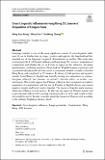Files in this item
Cross-linguistic influence in Hong Kong ESL learners’ acquisition of conjunctions
Item metadata
| dc.contributor.author | Kong, Ming Sum | |
| dc.contributor.author | Carr, Mary M. | |
| dc.contributor.author | Chong , Sin Wang | |
| dc.date.accessioned | 2023-09-05T12:30:02Z | |
| dc.date.available | 2023-09-05T12:30:02Z | |
| dc.date.issued | 2023-08-26 | |
| dc.identifier | 292655816 | |
| dc.identifier | cdf631b5-aa22-42f3-809f-203e0b5a2acf | |
| dc.identifier | 85169105551 | |
| dc.identifier.citation | Kong , M S , Carr , M M & Chong , S W 2023 , ' Cross-linguistic influence in Hong Kong ESL learners’ acquisition of conjunctions ' , Fudan Journal of the Humanities and Social Sciences , vol. 16 , pp. 515-539 . https://doi.org/10.1007/s40647-023-00384-y | en |
| dc.identifier.issn | 1674-0750 | |
| dc.identifier.other | ORCID: /0000-0002-4519-0544/work/141228049 | |
| dc.identifier.other | ORCID: /0009-0001-8222-9022/work/141643552 | |
| dc.identifier.uri | https://hdl.handle.net/10023/28314 | |
| dc.description.abstract | Language transfer is one of the most significant aspects of cross-linguistic influence. It can be divided into two types: positive and negative, the beneficial and detrimental use of one language’s acquired characteristics in another. This study aims to investigate the L1 (Chinese) influence on Hong Kong ESL learners’ acquisition of conjunctions and whether the use of L1 has an impact on this influence. An online questionnaire combining questions about students’ English learning experience and a grammatical judgement task was sent to a government-funded secondary school in Hong Kong and completed by 79 students. Evidence of both positive and negative transfer from Chinese to English was found by testing six conjunctions or conjunction pairs: although…but, because…so, not only…but also, either…or, neither…nor, and despite. The results suggest that Chinese is likely to have an impact on students’ acquisition of conjunctions, and the use of Chinese in English classes can worsen negative transfer and boost positive transfer. The degree of transfer might increase when more Chinese is used in class. To alleviate the impact of Chinese transfer and to provide more effective L2 teaching, monitoring the use of L1 and regular evaluation might be useful. Teachers can also adjust the amount of Chinese used according to the students’ English proficiency level. | |
| dc.format.extent | 25 | |
| dc.format.extent | 1003621 | |
| dc.language.iso | eng | |
| dc.relation.ispartof | Fudan Journal of the Humanities and Social Sciences | en |
| dc.subject | Cross-linguistic influence | en |
| dc.subject | Language transfer | en |
| dc.subject | Conjunctions | en |
| dc.subject | Hong Kong | en |
| dc.subject | ESL leaners | en |
| dc.subject | LC5201 Education extension. Adult education. Continuing education | en |
| dc.subject | MCC | en |
| dc.subject.lcc | LC5201 | en |
| dc.title | Cross-linguistic influence in Hong Kong ESL learners’ acquisition of conjunctions | en |
| dc.type | Journal article | en |
| dc.contributor.institution | University of St Andrews. University of St Andrews | en |
| dc.contributor.institution | University of St Andrews. International Education Institute | en |
| dc.identifier.doi | 10.1007/s40647-023-00384-y | |
| dc.description.status | Peer reviewed | en |
This item appears in the following Collection(s)
Items in the St Andrews Research Repository are protected by copyright, with all rights reserved, unless otherwise indicated.

